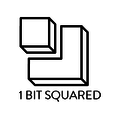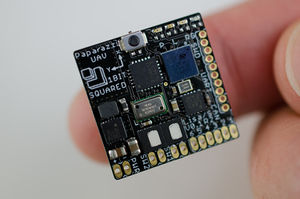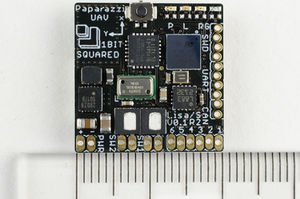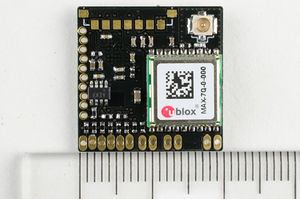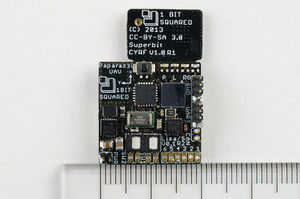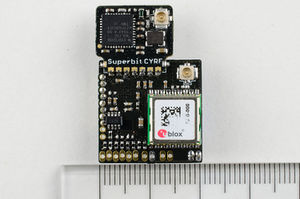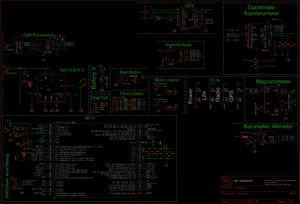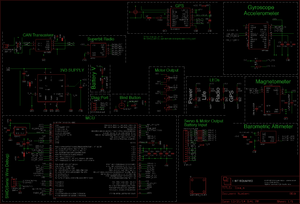Difference between revisions of "Lisa/S"
AutumnLeaves (talk | contribs) |
m (Deleted empty section "Block diagrams") |
||
| (7 intermediate revisions by 2 users not shown) | |||
| Line 41: | Line 41: | ||
So if you are ready to make your tiny plane fly autonomously,[http://1bitsquared.com/collections/frontpage/products/lisa-s you can already order one here] | So if you are ready to make your tiny plane fly autonomously,[http://1bitsquared.com/collections/frontpage/products/lisa-s you can already order one here] | ||
== | == Where to Purchase == | ||
[[File:1bitsquared_logo.png|100px|link=http://1bitsquared.com]] | [[File:1bitsquared_logo.png|100px|link=http://1bitsquared.com]] The Lisa/S Autopilot is available for purchase from [http://1bitsquared.com/products/lisa-s-starter-kit 1 BIT SQUARED]. | ||
== Pinout == | == Pinout == | ||
| Line 51: | Line 49: | ||
For a good example with which pins to connect where go to [[Lisa/S/Tutorial/Nano_Quadcopter]]. For more pinout info the site of manufacturer [http://cdn.shopify.com/s/files/1/0245/8645/products/LisaS_pinout_61ab6205-3e69-4602-8fbc-4c27ac55bbc4_1024x1024.jpg] | For a good example with which pins to connect where go to [[Lisa/S/Tutorial/Nano_Quadcopter]]. For more pinout info the site of manufacturer [http://cdn.shopify.com/s/files/1/0245/8645/products/LisaS_pinout_61ab6205-3e69-4602-8fbc-4c27ac55bbc4_1024x1024.jpg] | ||
== | == Servo connections == | ||
MOT1 (DC) = SERVO3 (PWM) = nb 0 (airframe) | |||
MOT2 (DC) = SERVO4 (PWM) = nb 1 (airframe) | |||
MOT3 (DC) = SERVO5 (PWM) = nb 2 (airframe) | |||
MOT4 (DC) = SERVO6 (PWM) = nb 3 (airframe) | |||
SERVO1 (PWM) = nb 4 (airframe, not compatible with I2C1) | |||
SERVO2 (PWM) = nb 5 (airframe, not compatible with I2C1) | |||
== Barometer == | == Barometer == | ||
| Line 81: | Line 85: | ||
[[Image:Lisa_s_1_0_r12_schematic.png|300px|thumb|none|Lisa/S V1.0 R12 Schematic]] | [[Image:Lisa_s_1_0_r12_schematic.png|300px|thumb|none|Lisa/S V1.0 R12 Schematic]] | ||
== Pre- | == Pre-Release v0.1 == | ||
One of the earliest versions of the board which is still used in the [http://www.mavlab.info/ MAVlab] of the TU-Delft is the Lisa/S V0.1R2. If you are not working there, this info is of no importance to you...Else as a reminder to all: This version is slightly different from newer versions: | One of the earliest versions of the board which is still used in the [http://www.mavlab.info/ MAVlab] of the TU-Delft is the Lisa/S V0.1R2. If you are not working there, this info is of no importance to you...Else as a reminder to all: This version is slightly different from newer versions: | ||
| Line 89: | Line 93: | ||
* Instead of four, only two brushed motors can be connected. | * Instead of four, only two brushed motors can be connected. | ||
= | =Lisa/S Nano Quadcopter Kit Assembly Tutorial= | ||
1. Go the the [[Lisa/S/Tutorial/Nano_Quadcopter|Lisa/S Nano Quadcopter Kit Assembly Tutorial]] Page to get a good explanation for how to connect your board to a Nano Quadcopter. | |||
[[Category:Lisa]] [[Category:User_Documentation]] [[Category:Autopilots]] | [[Category:Lisa]] [[Category:User_Documentation]] [[Category:Autopilots]] | ||
Latest revision as of 04:24, 28 November 2017
Lisa/S
Lisa/S is a very small general purpose autopilot. The main goal of creating an autopilot of minimal size and weight, while providing enough functionality to enable fully autonomous operation.
Mechanical Dimensions
- Size: 20mm x 20mm x 5mm (0.787" x 0.787" x 0.197")
- Weight: 2.8g (0.1oz)
Features
- 72MHz 32bit ARM Cortex M3 MCU with 16KB RAM and 512KB Flash
- Combined 3 Axis Gyroscope and 3 Axis Accelerometer
- 3 Axis Magnetometer
- Barometer (Altimeter)
- Onboard U-Blox GPS
- Pads to simply connect a Superbit CYRF RC and telemetry module
- Switching buck/boost converter allowing wide range of power input making it perfect and stable for operation from a 1S LiPO cell.
- 2 MOSFET switches connected to PWM output channels
- 6 PWM (servo) outputs
- 1 UART port
- 1 CAN interface
- 1 Bind/Boot tact switch
- SWD programming/debugging interface
- Size: 20mm x 20mm x 5mm (0.787" x 0.787" x 0.197")
- Weight: 2.8g (0.1oz)
Pictures
So if you are ready to make your tiny plane fly autonomously,you can already order one here
Where to Purchase
 The Lisa/S Autopilot is available for purchase from 1 BIT SQUARED.
The Lisa/S Autopilot is available for purchase from 1 BIT SQUARED.
Pinout
For a good example with which pins to connect where go to Lisa/S/Tutorial/Nano_Quadcopter. For more pinout info the site of manufacturer [1]
Servo connections
MOT1 (DC) = SERVO3 (PWM) = nb 0 (airframe) MOT2 (DC) = SERVO4 (PWM) = nb 1 (airframe) MOT3 (DC) = SERVO5 (PWM) = nb 2 (airframe) MOT4 (DC) = SERVO6 (PWM) = nb 3 (airframe) SERVO1 (PWM) = nb 4 (airframe, not compatible with I2C1) SERVO2 (PWM) = nb 5 (airframe, not compatible with I2C1)
Barometer
In order to use the barometer, you just need to add one line to your firmware block (in your airframe file) :
| File: conf/airframes/myplane.xml |
<firmware name="fixedwing">
<target name="ap" board="lisa_s_0.1">
...
</target>
...
<define name="USE_BAROMETER" value="TRUE"/>
...
</firmware>
|
Once that line is added to the airframe file, you should be able to get the values of the barometer and paparazzi is going to take them into account when doing it's calculations.
Warning : the barometer doesn't seams to be working at a higher frequency than 120Hz in a fixed wing airframe. Than mean that in a fixed wing airframe the PERIODIC_FREQUENCY must be equal or lower than 120. In rotorcraft the barometer works fine.
Schematics
Pre-Release v0.1
One of the earliest versions of the board which is still used in the MAVlab of the TU-Delft is the Lisa/S V0.1R2. If you are not working there, this info is of no importance to you...Else as a reminder to all: This version is slightly different from newer versions:
- The SWIO and GND pin from the Serial Wire Debug (SWD) headers are flipped, such that the order becomes TRACE-SWCLK-SWDIO-GND.
- There is no capacitor to enable a warm start for the GPS.
- Instead of four, only two brushed motors can be connected.
Lisa/S Nano Quadcopter Kit Assembly Tutorial
1. Go the the Lisa/S Nano Quadcopter Kit Assembly Tutorial Page to get a good explanation for how to connect your board to a Nano Quadcopter.

